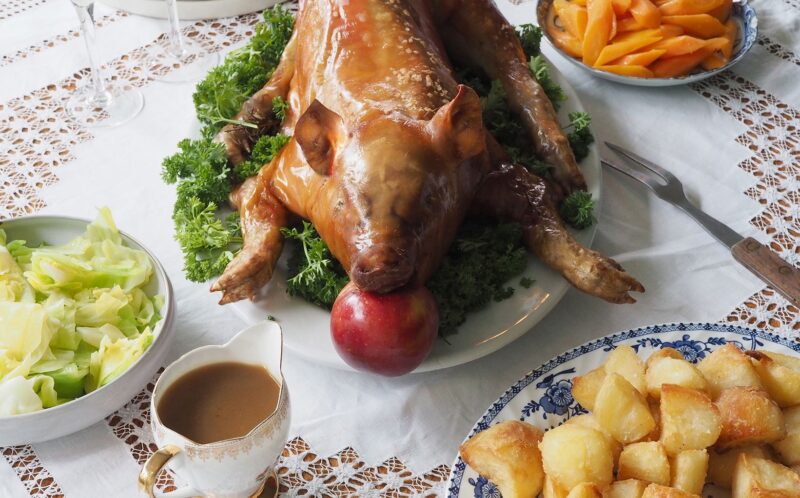Cooking a succulent roast pig, also known as a traditional roasted pig or piglet roast, is a specialty pork dish that is guaranteed to impress. While the idea of cooking a whole roasted pig may seem intimidating, the end result is worth the effort and skill required.
Let me guide you through the art of roasting a tender pig roast from start to finish.
Key Takeaways:
- Cooking a whole roasted pig is a famous pork dish that is sure to impress your guests.
- Choosing the perfect suckling pig is crucial for a successful pig roast. Size and tenderness are key factors to consider.
- Preparation and seasoning are essential steps in achieving a succulent and flavorful roasted pig. Proper washing, barding with garlic cloves, and applying the right combination of oil and kosher salt are essential.
- Roasting the suckling pig at a low temperature for several hours ensures a tender and delicious result. Increasing the oven temperature at the end of the cooking process helps achieve crispy, golden skin.
- Resting the roasted pig before carving is important for juices to redistribute, and serving it with pan juices and a fresh herb garnish adds a final touch of flavor.
- Alternative cooking methods, such as using a grill or rotisserie rig, require different techniques and equipment, but can also yield mouthwatering results.
The Art of Roasting a Suckling Pig
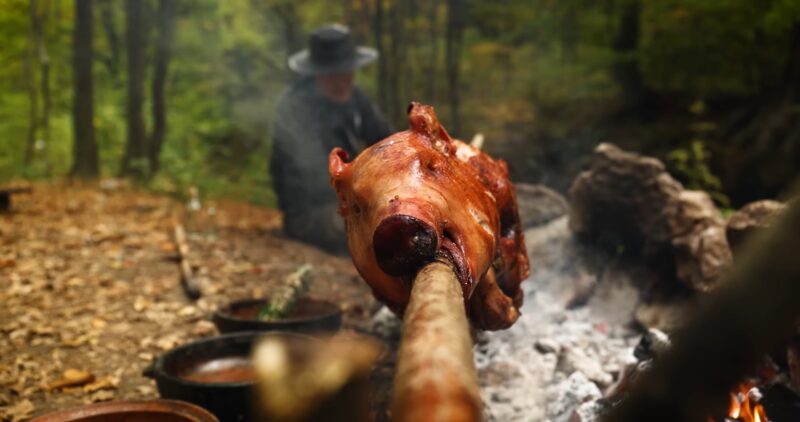
Roasting a suckling pig is a culinary experience that showcases both skill and tradition. The process of preparing and cooking a whole pig requires careful attention to detail to achieve the ultimate succulent roast pig. To begin, select a small suckling pig weighing around 15 to 20 pounds, ensuring it is of high quality and freshness.
Once you have your pig, the preparation begins with a thorough washing. Take the time to clean the pig inside and out, removing any impurities or residual hair. After washing, it’s time to add flavor and aroma by barding the pig with garlic cloves. This technique involves inserting the cloves into the fatty layers of the pig to infuse it with a rich, savory taste.
Seasoning plays a crucial role in achieving the desired taste and tenderness. Rub the pig with oil to promote juiciness and then dust it evenly with kosher salt to enhance the flavors. This combination of oil and salt creates a delectable crust on the roasted pig.
When it comes to cooking, patience is key. Slow-roasting the pig at a low temperature of 300 degrees Fahrenheit for about 4 to 5 hours ensures the meat remains tender and juicy. To maintain moisture, periodically add water to the roasting pan during the cooking process. To add that final touch of perfection, increase the oven temperature to 450 degrees for the last half-hour, allowing the skin to crisp and turn golden brown.
Once the pig reaches an internal temperature of 160 degrees or when the skin has inflated and separated from the flesh, it’s time to let the pig rest. Allowing the pig to rest for 45 minutes ensures the juices redistribute, resulting in optimal tenderness. Before serving, replace the potato in the pig’s mouth with an apple for an added touch of flavor. Serve the succulent roast pig with its pan juices and garnish with fresh herbs for an unforgettable feast.
| Ingredients | Instructions |
|---|---|
| Small suckling pig (15-20 pounds) | 1. Wash the pig thoroughly, removing any impurities. 2. Bard the pig with garlic cloves, inserting them into the fatty layers. 3. Rub the pig with oil and dust it evenly with kosher salt. 4. Place a potato in the pig’s mouth. 5. Roast the pig in a 300°F oven for 4-5 hours, adding water if needed. 6. Increase the oven temperature to 450°F for the last 30 minutes to crisp the skin. 7. Check the pig’s internal temperature (160°F) or skin separation for doneness. 8. Let the pig rest for 45 minutes before serving. 9. Replace the potato with an apple before serving, and garnish with fresh herbs. 10. Serve with pan juices. |
Choosing the Perfect Suckling Pig
When it comes to cooking a tender and succulent pig roast, selecting the perfect suckling pig is crucial. Here are a few factors to consider:
- Size: Opt for a small suckling pig weighing around 15 to 20 pounds. This ensures even cooking and tender meat.
- Tenderness: Look for a piglet with soft, pliable skin. This indicates that the pig is young and tender.
By choosing the right suckling pig, you set yourself up for a successful and delicious pig roast experience. Once you have your pig, it’s time to move on to the next step: preparation and seasoning.
Preparation and Seasoning
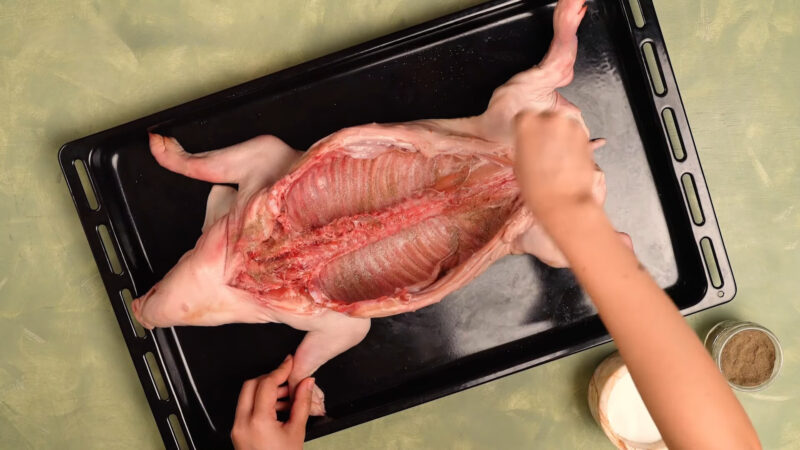
When it comes to cooking a succulent roast pig, preparation and seasoning are key. To begin, acquire a small suckling pig weighing around 15 to 20 pounds. This size is ideal for achieving tender meat and a delicious flavor. Before roasting, it’s important to thoroughly wash the pig, ensuring that all impurities are removed.
Once the pig is clean, the next step is to season it. To enhance the flavor, bard the pig with garlic cloves. This technique involves inserting cloves of garlic into the meat to infuse it with a rich, savory taste. After barding, rub the entire pig with a generous amount of oil, ensuring it is evenly coated. This will help to keep the meat moist during the roasting process.
To further enhance the flavor, sprinkle the pig with kosher salt. This will help to season the meat and create a delicious outer crust. Be sure to cover the entire pig with salt, ensuring an even distribution of flavors. Once seasoned, place the pig in a roasting pan and insert a potato into its mouth. This will help to maintain the shape and add moisture to the roast.
| Preparation and Seasoning – Steps |
|---|
| 1. Wash the pig thoroughly, removing any impurities. |
| 2. Bard the pig with garlic cloves to infuse it with flavor. |
| 3. Rub the pig with oil to keep it moist during roasting. |
| 4. Dust the pig evenly with kosher salt for added flavor. |
| 5. Place the pig in a roasting pan and insert a potato in its mouth. |
Following these preparation and seasoning steps will ensure that your roast pig is full of flavor and succulent to the bone. Now that the pig is ready, it’s time to move on to the roasting process.
Roasting the Suckling Pig
Roasting a suckling pig to perfection requires careful attention to detail and patience. Follow these steps for a succulent and tender pig roast:
- Preheat your oven to 300 degrees Fahrenheit.
- Prepare the suckling pig by washing it thoroughly and removing any blemishes or imperfections.
- Bard the pig by inserting garlic cloves into the skin, evenly distributed throughout the body.
- Rub the pig with oil, ensuring it is coated evenly, and then generously dust it with kosher salt.
- Place the pig in a roasting pan and insert a potato into its mouth to help retain moisture during the cooking process.
- Roast the pig in the preheated oven for approximately 4 to 5 hours, or until the internal temperature reaches 160 degrees Fahrenheit.
- If the pan becomes dry during cooking, add water to prevent the drippings from burning and to maintain moisture.
- Increase the oven temperature to 450 degrees Fahrenheit for the last half-hour of cooking to achieve a crispy and golden skin.
- The pig is done when the skin has inflated and separates from the flesh, and the internal temperature reaches the desired doneness.
After removing the pig from the oven, allow it to rest for at least 45 minutes before serving. This resting period allows the juices to redistribute, resulting in a more tender and flavorful meat.
When ready to serve, remove the potato from the pig’s mouth and replace it with a fresh apple for an added touch of flavor. Serve the roasted pig with the pan juices and garnish with fresh herbs for a visually appealing presentation.
It’s important to note that there are alternative methods for cooking a whole pig, such as using a grill or rotisserie rig. However, these methods require different techniques and equipment. For the best results, follow the steps outlined above to achieve a delicious and mouthwatering whole pig roast.
| Cooking Temperature | Roasting Time | Internal Temperature |
|---|---|---|
| 300°F | 4-5 hours | 160°F |
| 450°F | 30 minutes | N/A (for crispy skin) |
Achieving Crisp, Golden Skin
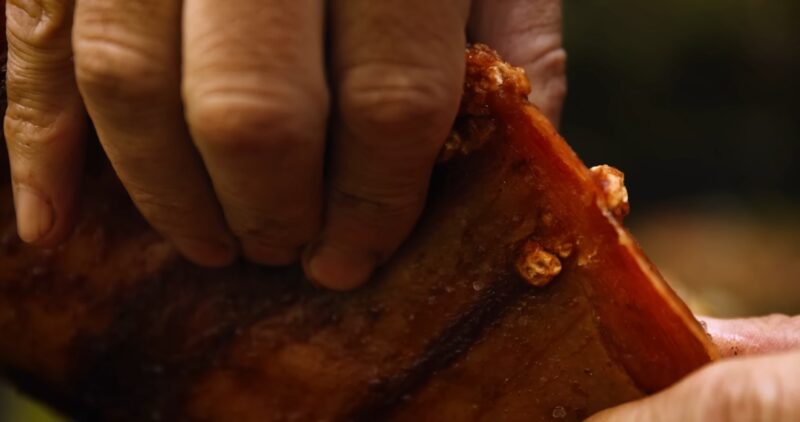
Roasting a suckling pig is a labor of love, and one of the most anticipated moments is achieving that perfect, crispy, golden skin that is both visually stunning and incredibly delicious. To accomplish this culinary feat, there are a few key steps to follow.
First, after the pig has been roasting at a low temperature for several hours, it’s time to turn up the heat. Increase the oven temperature to 450 degrees Fahrenheit for the last half-hour of cooking. This high heat will help to crisp the skin and create that desirable golden color.
Another technique to enhance the crispiness of the skin is to prick it gently with a fork before increasing the oven temperature. This allows the fat to render out more effectively and helps to achieve a beautiful texture.
Lastly, periodically baste the pig with its own juices during the cooking process. This will not only add flavor but also promote even browning and a crispy skin all around.
Once the pig has reached an internal temperature of 160 degrees Fahrenheit and the skin has become crisp and golden, remove it from the oven and let it rest for at least 45 minutes. This resting time allows the juices to redistribute throughout the meat, resulting in a tender and succulent roast pig.
| Key Tips: | |
|---|---|
| 1 | Turn up the oven temperature to 450 degrees Fahrenheit for the last half-hour of cooking for a crispy, golden skin. |
| 2 | Gently prick the skin with a fork to help render the fat and enhance crispiness. |
| 3 | Baste the pig with its own juices during cooking to promote even browning and flavor. |
| 4 | Let the pig rest for at least 45 minutes before carving to allow the juices to redistribute for a tender and succulent result. |
By following these steps and employing these techniques, you can achieve that coveted crisp, golden skin that will make your whole roasted pig truly mouthwatering and memorable.
Resting and Serving the Roasted Pig
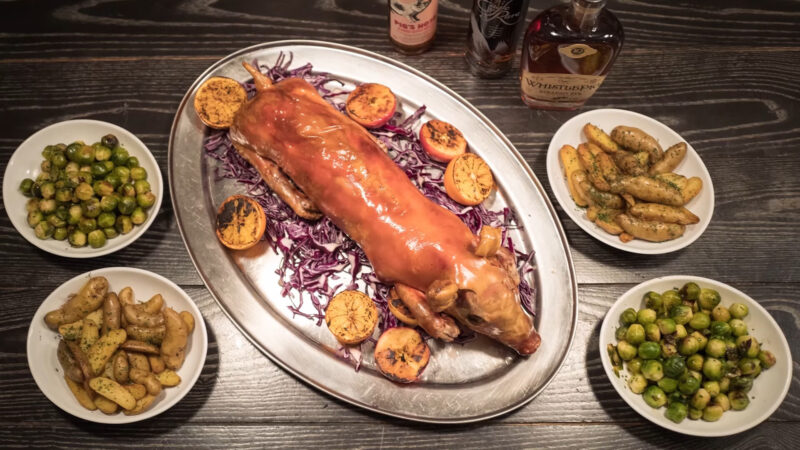
Once you have successfully roasted your succulent pig to perfection, it is crucial to let it rest before carving. This resting period allows the juices to redistribute within the meat, resulting in a moist and tender final product. Give the pig at least 45 minutes to rest, ensuring that the flavors have time to meld together.
While the pig is resting, take the opportunity to prepare the pan juices. Skim off any excess fat from the pan and set it aside. Place the pan on the stove over medium heat and deglaze it with a flavorful liquid such as apple cider or white wine. Scrape up any browned bits from the bottom of the pan, allowing them to dissolve into the liquid. Let the liquid simmer until it reduces slightly and intensifies in flavor.
When you are ready to serve the roasted pig, carefully transfer it to a large cutting board. Remove the potato from its mouth and replace it with a fresh apple, which adds a delightful hint of sweetness. Use a sharp knife or carving set to carve the pig into portions, separating the different cuts for easy serving.
Serve the succulent roast pig on a platter, drizzled with the pan juices and garnished with a generous amount of fresh herbs such as rosemary or thyme. The aroma and presentation of the whole roasted pig are sure to impress your guests and make it a memorable dining experience.
| Ingredients: | Instructions: |
|---|---|
| Whole roasted pig | 1. Let the pig rest for 45 minutes after roasting. |
| Pan juices | 2. Skim off excess fat and deglaze the pan with a flavorful liquid. |
| Fresh herbs | 3. Garnish the roasted pig with an abundance of fragrant herbs. |
| Apple | 4. Replace the potato in the pig’s mouth with a fresh apple for a touch of sweetness. |
Alternative Cooking Methods
If you’re looking for a unique and delicious way to prepare a piglet roast or a whole roasted pig, there are alternative cooking methods that you can try. These methods offer different flavors and textures, and can be a great way to impress your guests with a specialty pork dish. Let’s explore some of these alternative cooking methods:
Grilling:
Grilling a piglet roast or a whole roasted pig adds a smoky and charred flavor that is hard to resist. To grill a pig, you will need a large charcoal or gas grill and a rotisserie attachment. Start by marinating the pig with your favorite herbs, spices, and marinade.
Then, secure the pig on the rotisserie and set it up on the grill. Cook the pig low and slow, rotating it periodically to ensure even cooking. Keep an eye on the temperature and adjust the heat as needed. The result will be a tender and juicy pig with a delectable crispy skin.
Rotisserie Rig:
A rotisserie rig is another popular method for cooking a whole roasted pig. This method involves rotating the pig over an open flame or a heat source for an extended period of time. The pig is secured on a large skewer or spit and slowly rotated to ensure even cooking.
This method allows for the pig’s fat to drip away, resulting in a crispy and flavorful skin. It’s important to monitor the temperature and adjust the heat as needed to achieve the desired doneness.
When opting for alternative cooking methods, it’s essential to have the right equipment and practice proper safety precautions. Always ensure that the pig is cooked thoroughly and reaches a safe internal temperature.
Additionally, consider the size of the pig and the number of guests you are serving when choosing the cooking method. Whatever method you choose, a suckling pig cooked to perfection will surely be a showstopper at your next gathering.
| Alternative Cooking Methods | Key Points |
|---|---|
| Grilling | – Adds a smoky and charred flavor – Requires a rotisserie attachment – Cook low and slow for tender and juicy meat |
| Rotisserie Rig | – Rotates the pig over an open flame – Results in a crispy and flavorful skin – Monitor temperature and adjust heat as needed |
FAQ
What size should the suckling pig be for a whole pig roast?
It is recommended to acquire a small suckling pig weighing around 15 to 20 pounds for a whole pig roast.
How should I prepare the suckling pig before roasting?
Wash the pig thoroughly and rub away any imperfections. Bard the pig with garlic cloves, rub it with oil and dust it evenly with kosher salt.
What is the ideal oven temperature for roasting a suckling pig?
Roast the pig in a 300-degree Fahrenheit oven for about 4 to 5 hours, adding water to the pan if needed. Increase the oven temperature to 450 degrees for the last half-hour to crisp the skin.
How do I know when the pig is done?
The pig is done when it reaches an internal temperature of 160 degrees or when the skin has inflated and separated from the flesh.
How long should I let the pig rest before serving?
It is recommended to let the pig rest for 45 minutes before serving.
Can I use a grill or rotisserie rig to cook a whole pig?
Yes, using a grill or rotisserie rig is an alternative method for cooking a whole pig, but it requires different techniques and equipment.
Conclusion
Roasting a suckling pig combines artistry, skill, and patience, resulting in a dish with a crispy exterior and tender meat. For optimal flavor, choose a quality piglet, infused with garlic, and season with oil and salt.
After roasting, allow the pig to rest and serve with pan juices and fresh herbs for a memorable meal. Beyond traditional oven roasting, grilling adds a smoky flavor, while rotisserie methods create a crispier skin.
Whichever technique is chosen, prioritize safety and thorough cooking to elevate the pig roast experience for your guests.

